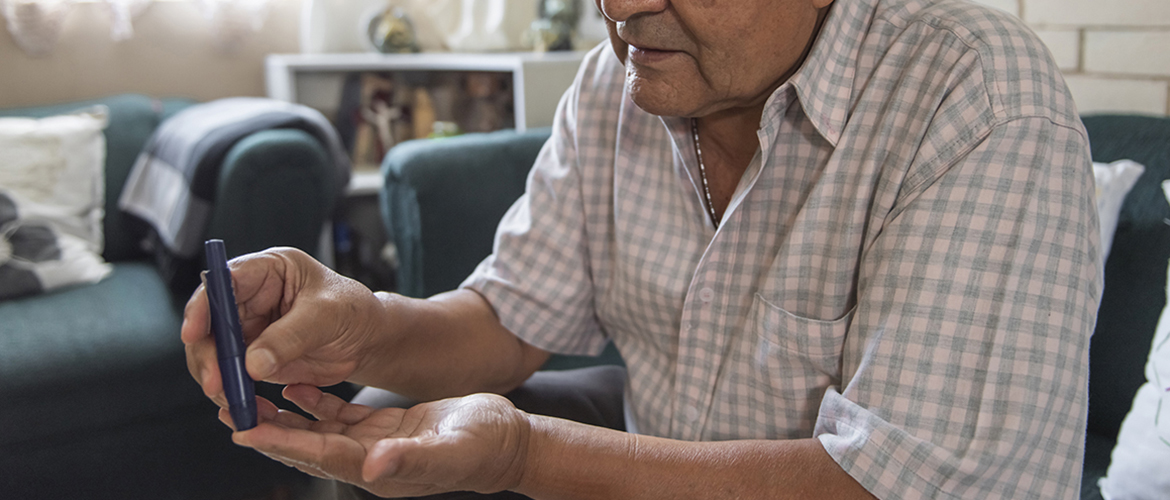Nurse Laura Lara says she’s not surprised to find people with high blood sugar levels during the diabetes screenings she performs at community events for the nonprofit Proyecto Juan Diego in Brownsville, Texas.
In Texas’ Rio Grande Valley, 26% of adults have been diagnosed with diabetes, according to the University of Texas Rio Grande Valley. That’s more than double the number diagnosed statewide, data from the Kaiser Family Foundation shows.
What Lara finds alarming is the number of young people with dangerously high blood sugar levels. Before she screens them, they share suspicions of having diabetes, describing the tingling they feel in their hands and feet — symptoms of diabetic neuropathy.
“These are young people, in their late 30s, with A1C levels at 12,’” she says, which increases risks of long-term diabetes complications like blindness, nerve damage and kidney failure. “They do have insurance, but they don’t go to the doctor.”
As Lara speaks, Lidiana Ramirez, Proyecto Juan Diego’s executive director, holds up her hands and wiggles her fingers, imitating the hand tingling. “That’s a lot of what we deal with,” she says. “We’re trying to increase awareness, but we still have a lot of work to do.”
With support from Health Care Service Corporation’s Texas plan, Proyecto Juan Diego, a multipurpose center for low-income and immigrant residents, started diabetes education classes for patients diagnosed with diabetes and prediabetes to help them make lifestyle changes and become healthier. It also performs diabetes screenings and provides some patients with equipment to help with monitoring, including wireless scales, blood pressure cuffs and glucometers.
Proyecto Juan Diego is among several community organizations HCSC is supporting through its 2023 major grant program. Besides Texas, HCSC also is providing more than $9 million to organizations in Illinois, Montana, New Mexico and Oklahoma to address social determinants of health, including nutrition and access to transportation and physical activity.
“HCSC is pleased to contribute to the resilience and ongoing efforts of local community organizations in driving positive change,” says Clarita Santos, HCSC executive director of corporate and civic partnerships. “The meaningful impact they make every day reflects our commitment to expanding access to care, supporting community development and addressing social determinants of health.”
In Illinois, New Mexico and Oklahoma, nonprofit organizations and clinics also are taking on the scourge of diabetes rampant in their communities by providing patients nutrition and diabetes management education.
“Patients and providers are actively having conversations about what’s realistic for them and setting smart goals."
On Chicago’s South Side, Community Christian Health Center hired a dietitian nutritionist and helped about 200 patients increase access to healthy foods and adopt healthier lifestyles. In 2022, 9% of its patients had been diagnosed with diabetes and nearly 50% were overweight or obese because of poor diets, lack of exercise and living in food deserts, which complicated their condition management.
Now, patients identified as having prediabetes are referred for wellness education to focus on prevention, says Shaune Freeman, the center’s population health and care management director.
“We’re able to see what’s realistic in terms of setting reasonable goals and documenting them in patient charts,” he says. “Patients and providers are actively having conversations about what’s realistic for them and setting smart goals. We can do all of this in-house.”
Along the U.S. border, Southern New Mexico Diabetes Outreach, a nonprofit offering diabetes prevention and management education, tries to fill in care gaps throughout the area. The organization primarily provides health and wellness screenings, support groups for Type 1 and Type 2 patients and diabetes education classes for those newly diagnosed or struggling with management and nutrition.
SNMDO receives patient referrals from many health clinics and travels throughout the state’s vast frontier and rural areas to offer help, motivation and limited diabetes supplies. It serves about 10,000 people annually.
“We see people in various states of health,” says SNMDO Executive Director Selena Gomez. “We do see a lot of diabetes burnout. They give up and go days or weeks without medication and end up in the hospital. People get very depressed, especially children who are newly diagnosed with type 1 diabetes.”
In Oklahoma City, Mercy Hospital’s Good Samaritan Clinic is helping uninsured adult patients with diabetes learn how disease management can improve their lives and lead to fewer emergency room visits. Many patients, mostly Spanish-speaking immigrants, have sought treatment at emergency rooms and urgent care centers — considered their only options for care, says Morgan Rozzell, the clinic’s advanced practice registered nurse. A lack of access to preventive care and education has put them at a significant disadvantage.
At Good Samaritan, 40% of patients have diabetes. Many others have risk factors for the condition – obesity, high blood pressure or a strong family history of diabetes.
“We want to help them shift their focus and learn that life can lived more fully when they are feeling better,” says Rozzell, adding that many patients don’t seek care until they experience diabetic neuropathy, one of the first symptoms of the condition. “They feel like a failure for not managing it.”

